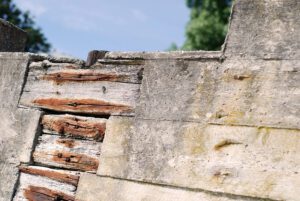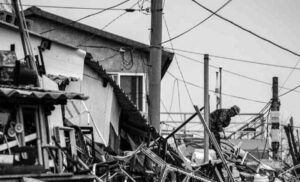
When your home or business resides along the ocean, you don’t want it to go into the ocean. Understandably so. Structures meant for land don’t work well when they’re part of an underwater city. You want to make sure your seawall doesn’t fail.
Seawalls will inevitably fail over time. That said, you can take preventative measures to make them last longer before needing to be repaired or replaced.
Dalinghaus Construction wants to give you tips to prevent seawall failure. That way you won’t need to take on costs sooner than later.
How to know if a seawall is failing
Your seawall won’t look anything like when it was first constructed. There will be signs and symptoms of your seawall failing.
Signs and symptoms of a failing seawall
Soil Loss
- Water crashes on the seawall all the time as the tides continuously change. When the water pulls back, the soil goes with it.
Leaning
- Your seawall is building up enough hydrostatic pressure that it looks like it’s part of a Michael Jackson tribute group doing the famous lean.
Deterioration
- Salt will naturally eat away your seawall and cause some concrete spalling.
Cracking
- You’ll identify large cracks when you take a look at your seawall.
Oxidizing rebar
- This isn’t as noticeable but can cause larger damage. As the rebar oxidizes, it expands.
- As water crashes into the seawall, you’ll see rust stains that make your wall look as though it’s weeping.
What makes a seawall fail?
Salt from the ocean
Any water can lead up to a seawall failing. However, salt likes to eat everything. Concrete is no exception.
This is a problem engineers have been trying to combat with seawalls.
Concrete is porous, meaning water will eventually make it to the rebar.
Hydrostatic pressure
When the waves hit, water goes flying everywhere. The soil behind your seawall isn’t immune to getting wet. As water builds up, the soil soaks it in, causing your seawall to retain a larger load.
Improper seawall construction
It would be nice if every construction project was done well, but this isn’t always the case. The concrete may not have been mixed correctly, or there was too much rebar.
Seawall depth
Your seawall is more likely to be exposed to water the deeper it goes. Different pressures are applied as the tides change.

Seismic activity
We can’t control earthquakes in Southern California. Even the best construction job is susceptible to damage via seismic movement.
Age
Like humans, seawalls deteriorate over time.
Preventing seawall failure
The sad truth is seawalls will inevitably fail at some point. However, that doesn’t mean you shouldn’t do anything. You can at least prolong their strength before they need to be repaired or replaced.
Installing and cleaning filters installed
You definitely want filters for water to come out of the seawall back toward the ocean or some other mass of water. Yes, some filters prevent water from coming in and having water exit from the soil it retains.
These are important for preventing hydrostatic pressure and making your wall lean like the tower of Pisa.
The filters must be maintained so the soil isn’t coming out or blocking the exit. They need to be cleaned every so often so they’re not clogged.
They’re like weep holes except with fantastic filtration. The filters prevent the soil from eroding.
They’re necessary for when the tides rise and sink, messing with the hydrostatic pressure applied to your seawall. The tides will eventually erode the soil. When water is filtered back out, it takes soil with it. You’ll inevitably get soil erosion.
You could technically clean these out on your own. However, the filters should be maintained by whoever installed them to come and do the maintenance to make sure it’s removed correctly, cleaned correctly, and put back in right.
Regardless, you want those filters looked at to make sure they’re doing the job they’re meant to do.
Make sure the concrete looks okay
If you start to see failure, it’s better to catch them at their beginning stages. You don’t want those problems to be exacerbated. Those issues will cost you more money if they get worse over time.
A bigger problem will be a bigger cost.
Consider having a jetty area in front of your seawall
This isn’t a must and there are some circumstances a jetty won’t be practical to install. It could prevent your seawall from failing at an earlier date. They are built to maintain a seawall given they take the brunt of the waves. And they elongate the soil erosion process since that barrier can help maintain the soil.
Have someone inspect your seawall regularly
You can have someone come out yearly to make sure your seawall is doing its job correctly.
Stabilize soil behind the seawall
This will prevent wall failure by injecting polyurethane into the ground.
Polyurethane is an environmentally safe foam injected into the ground to stabilize the soil behind the seawall to prevent failure.
Check out our dangers of polyurethane article to understand how the foam is environmentally friendly.
Can I maintain a seawall on my own?
I wouldn’t recommend it. It’s pretty much a must to have a contractor do maintenance. It would have to be a specialized contractor.
Whatever issues your seawall is having, make repairs when you notice problems. You don’t want your cost to increase from further damage.
Cost of seawall repair

An average seawall repair can cost between $25,000-$30,000 for a homeowner. Again, this depends on the extent of the damage. It can cost much more if the damage is significant enough.
Larger walls could have a higher cost.
You know more about how to prevent seawall failure. Schedule an appointment to have your seawall inspected.
You’ve learned the signs of a failing seawall, what causes them to fail, and how to prevent further failure. If you’re still concerned about seawall failure, schedule a FREE seawall evaluation today.
In the meantime, check out our article on the signs and symptoms of a failing seawall.
Also, check out the six causes of seawall failure
For additional questions or to schedule an evaluation, call Dalinghaus Construction at (877)360-9277







One Response
I appreciate the way you mentioned that a skilled contractor is necessary for seawall maintenance. Hiring a professional makes sense because they are knowledgeable and may assist you avoid making expensive blunders. So that people know to hire a professional for this kind of job rather than handling it on their own, I’ll be sure to share this with family and friends.